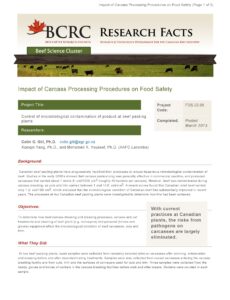How do Carcass Processing Procedures Impact Food Safety?
Canadian beef packing plants have progressively and effectively modified their processes over time to reduce the levels of harmful bacteria contamination on product. Studies have shown that carcass pasteurizing is generally effective in commercial practice, but cuts and trim carry more E. coli than beef in its whole carcass state. Therefore beef is being contaminated during carcass breaking. What’s the source of the bacteria?
A recently-completed research project, funded by the National Check-off and Canada’s Beef Science Cluster, worked to determine how
- beef carcass dressing and breaking processes,
- carcass and cut treatments and
- cleaning of both plant equipment (e.g. conveyors) and personal equipment (knives and gloves)
affect the microbiological condition of beef carcasses, cuts and trim.
The study found that careful dressing and effective carcass cleaning practices used in large commercial packing plants can essentially eliminate E. coli from whole carcasses. Smaller plants that cannot afford to install costly equipment can still produce carcasses that carry very few E. coli by drying carcasses during chilling. Personal equipment was the source of most of the E. coli deposited on cuts. Conveyer belts, to a lesser extent, were also a source of contamination.
Following treatment of carcasses, bacterial contamination can be wholly avoided by ensuring that hands, cotton gloves, steel mesh gloves and knives are thoroughly and regularly cleaned, and by wearing disposable rubber gloves between cotton gloves and steel mesh gloves. Control of bacterial contamination from conveyors and other fixed equipment has benefited from improved equipment cleaning processes developed in recent years, and can be enhanced by thoroughly drying equipment after it has been cleaned.
To learn more about this research, view the fact sheet.
The sharing or reprinting of BCRC Blog articles is welcome and encouraged. Please provide acknowledgement to the Beef Cattle Research Council and list the website address, www.BeefResearch.ca.
We welcome your questions, comments and suggestions. Contact us directly at [email protected] or generate public discussion by posting your thoughts below.
Stay connected by following us on Twitter @BeefResearch, liking us on Facebook, and subscribing to our YouTube Channel.
Click here to subscribe to the BCRC Blog and receive email notifications when new content is posted.
